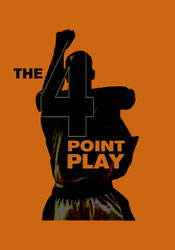Only humble great players can accept leveraging their diminishing skills into lesser roles for more wins. For one thing, most terrific, cornerstone, franchise foundation, meteoric ballers are treated as such, and therefore have a hard time admitting when their abilities have deteriorated beyond the point of fancy shots falling. Hangers-on endorse them to no end, baby mothers ask for more money, and the expectations only increase with every All-Star appearance. When that rueful day comes, when their vertical leap measures the height of a cinder block, some walk off slowly, but most live through a bevy of trades to worse teams in smaller markets at each stop. Allen Iverson went the way of the dodo as soon as some GM leaked the inside information that he looked a few steps slower in practice. Shaquille O'Neal turned from NBA's greatest giant to traveling sideshow in the span of a year.
Ron Artest stands out because of how his career made that turn both abruptly and ungracefully, and in a simultaneous series of events his personal struggles multiplied in that tumultuous two-year period. However unceremonious his decline, he ironically found success right there in his worst statistical years. Mainly, it's because he modified what he did on the court so that his specialties were narrower but more powerful in the end. Ron Artest became a defender who could shoot three-point shots, as opposed to a multi-faceted scorer who could defend in stretches, and it made him more valuable to franchises over time.
That journey from uncommonly skillful star to targeted role player marked a psychological transition for Artest that he would later comment on with wispy appreciation. The 2003-04 season revealed him as the league's premiere defender. In showdowns with its pre-eminent stars, he could frustrate them into bad games. Dirk Nowitzki shot 40% against Artest's hammering defense -- on two occasions. LeBron James had 11 turnovers, basketball's version of the forced error, in three losses against the Indiana Pacers. And in a climate where high school phenoms had become the new mutant-era superheroes, his play, rumbling in the lane and facing up to difficult defensive challenges, seemed pedestrian in comparison to the feats of LeBron James, Tracy McGrady and Kobe Bryant (although he regularly found ways to perplex and defeat them). Artest could not dunk the ball above the cylinder or fly in for blocks. He could barely outrun his own fleet team, but his foot speed never determined how good he was. The most telling evidence of his undervalued status was Ron's quiet reaction to being selected to the All-Star team in 2004. In the year prior to Artest's selection, LeBron James's exclusion had been the subject of much debate. Even in the Cavaliers' mediocre season, James was now an object of public adoration, the coveted forward in the East who proved that college training was no longer necessary in the professional ranks. Just as famously, Michael Jordan was selected to the East All-Star team in a wave of nostalgia that effectively consumed the media, who still ached to complete the Greatest Basketball storyline. Once again, in Artest's most inspired seasons, he was merely a footnote until he did something wrong. He had been bookended by the positive dreams of the future and the noble relics of the past. All the while, he played brilliantly, recording 35 20-point games, 2 30-point games, and collecting 152 steals (15 shy of the leader that year).
Pacers who fit the same mold of high-school standout turned pro also overshadowed Ron Artest, Jermaine O'Neal for his sterling play as a rebounder and scorer, and Al Harrington mostly for his promise.
The Defensive Player of the Year award Ron earned that year may have been the worst kind of consolation prize for a man who seriously committed his efforts to become one of the best players in the world, on either end of the floor. Though he played similarly ferocious defense in the three years that followed the award, he never reached that pinnacle of "best" at anything after his crown achievement as D.P.O.Y. To that end, Ron Artest was the leader in unofficial awards and unheralded skills, but never the face of the NBA. He was too busy acting as its notorious scapegoat, staving off the critic and his own personal troubles to become the devastating perimeter player many initially doubted he could be. What's worse, as Artest began to adjust his mental game to the realities of an aging body and increasingly harsh opinions of his effect on teams, he had already been traded two times. The clock on his career was ticking and his ability to affect the game holistically was diminishing in concert.
No matter how crazed Ron Artest was (the words "crazy" and "Artest" appear in 64 headlines from 2003-2010), his statistical production mirrored his commitment to fitness and defensive impact. Gradually, Ron's efforts floated from scoring in the middle of the paint, defined by bullishness and forcing the opposition to respond, to the metaphorical sidelines, learning to shoot the long ball more accurately and confine guards to the ropes.
In that way, Artest is the model player for TheFourPointPlay and will be a figure this journal focuses on in depth, both in terms of his recorded output and his psychological movements.

No comments:
Post a Comment